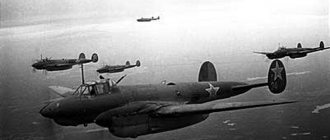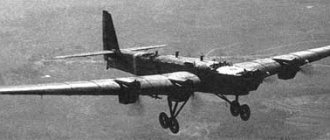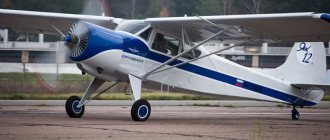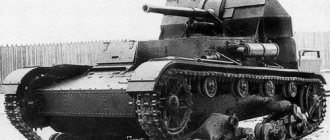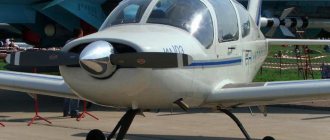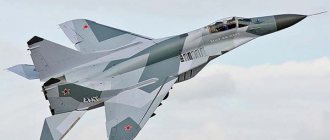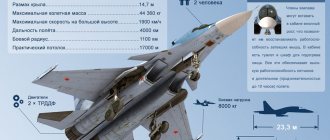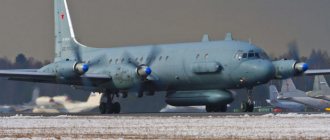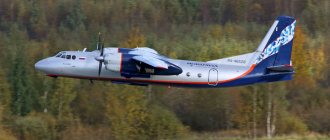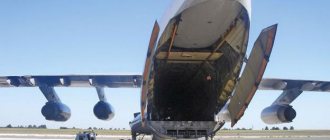It is generally accepted that the fastest aircraft are fighters. However, in the 70s, a heavy missile carrier was built in the Soviet Union, and no fighter in the world could compete with its speed. It was a T-4, which was designed at the Design Bureau named after. P. Sukhoi.
The history of the creation of the T-4 aircraft
In the early 60s, the USSR achieved strategic parity with its main rival in the global confrontation - the United States of America. This happened thanks to the accelerated development of bomber aircraft and nuclear missile systems. Both sides did not stop there and continued the arms race.
The United States has improved its strategic arsenals and achieved serious success in this. Prototypes of the XB-7 Valkirie strategic bomber and SR-71 Blackbird reconnaissance aircraft took to the skies. The Pentagon began creating the B-1 strategic bomber, potentially the most advanced air strike system. One after another, nuclear submarines and powerful floating airfield aircraft carriers were added to the American Navy. The USSR could not ignore such a threat.
In 1963, the Soviet military set the task of creating a strategic aviation strike and reconnaissance complex that could find and destroy any targets at ranges of up to 7 thousand kilometers using guided missiles. The priority among them was the aircraft carrier groups of the potential enemy. A competition was announced among design bureaus. The design bureaus of Pavel Sukhoi, Andrei Tupolev and Alexander Yakovlev presented their projects. The winner was the T-4 model proposed by Sukhoi.
This was an unexpected decision, because the Sukhoi Design Bureau specialized in light front-line fighters and interceptors, and here is a strategic missile carrier weighing 100 tons. The main trump card of the T-4 was the highest cruising flight speed - 3200 km/h (three speeds of sound). This promised complete invulnerability of the vehicle when breaking through enemy air defenses.
The patriarch of Soviet bomber aviation, Andrei Tupolev, strongly objected to the transfer of the project to Pavel Sukhoi. Unofficially, the T-4 aircraft was called “weaving” because of the take-off weight of the machine. The development of the project was headed by Naum Chernyakov. He already had experience working on strategic intercontinental systems. In the 50s, he was the chief designer of the supersonic unmanned two-stage cruise missile "Storm". She could fly over distances of several thousand kilometers at a speed of 3500 km/h.
When creating "Storm", titanium was widely used for the first time - a lightweight metal that can withstand extreme temperatures. It has become indispensable in conditions of prolonged flight at supersonic speeds. The project was closed in 1960, but many developments on the “Bure” (heat-resistant materials, technologies for their processing) were used in the construction of the T-4.
T-4 design
Almost everything in the design of this machine was new and unknown. Therefore, work on the aircraft made it possible to raise many branches of science and technology to new heights. T-4 became a kind of technical university through which the participants in its creation passed. In general, during the creation of the T-4, 600 inventions were introduced. Not a single aircraft built by that time in the USSR had such a large number of original designs.
Together with the Sukhoi Design Bureau, scientists from the Central Aerohydrodynamic Institute actively worked on the development of the Sotka. They took part in the development of the aerodynamic design and a unique control system. The designers chose a canard layout, which included the front horizontal tail. To reduce drag, they decided to make the bow part movable. During takeoff and landing, the pilot would tilt it down and close it during flight, piloting the plane using instruments only. This was an extremely risky decision. However, it promised a big increase in speed.
They decided to make the body of the car mixed - from titanium and steel. The original aircraft required no less original engines that were capable of performing normal work in the most severe temperature conditions and rarefied air. Such power plants were made in Rybinsk. The air intakes and four engines were installed under the Sotka fuselage in one package. Wits immediately nicknamed this scheme a “communal bed.” For the first time in domestic practice, an ultra-reliable electric-remote control system with quadruple redundancy was used on an aircraft.
New solutions
Unfortunately, such a wonderful idea was not realized. If the layout scheme was maintained, the dimensions and weight of the new product increased sharply, but it was still not possible to accommodate the full volume of weapons.
Therefore, in the Sukhoi Design Bureau P.O. The specialists began primarily to develop a new layout scheme that would allow obtaining the maximum possible volumes with a minimum washed surface and ensuring the placement of the necessary weapons in the cargo compartments. At the same time, the structure had to be as rigid as possible so that the aircraft could fly near the ground at high speeds.
In addition, it was decided to exclude the propulsion system from the aircraft’s power circuit. In this case, it became possible to create new modifications with other engines. The new layout was supposed to maintain the ability to constantly improve the flight characteristics and technical data of the new product.
In the process of the designer’s work, they created an aerodynamic configuration, the integrated circuit of which was made of the “flying wing” type; rotary consoles of a small area (relatively small, of course) could change the sweep in flight.
Flight tests of the T-4 aircraft
08/22/1972. Test pilot Vladimir Ilyushin, together with navigator N. Alferov, took seats in the cockpit of the first prototype of the T-4. Designers, engineers, scientists, and representatives of the air force gathered at the airfield of the Gromov Flight Research Institute in the city of Zhukovsky. The car took off easily and quickly gained altitude. The Sotka turned out to be easy to pilot and had good stability and controllability.
The first forty-minute flight was successful and without any comments. “This is an airplane of the twenty-first century,” said Vladimir Ilyushin after a soft landing. According to the flight test plan of the first stage, nine flights of T-4 missile carriers took place. Their results literally brought customers from the Ministry of Defense into a state of euphoria. A kilometer per second is a speed that any enemy’s anti-aircraft weapons cannot cope with today, in the twenty-first century.
The hundred-ton car was controlled as easily as a regular fighter. The obtained flight characteristics completely coincided with the calculated ones. The Commander-in-Chief of the USSR Air Force, Chief Marshal of Aviation Pavel Kutakhov assessed Sukhoi’s plane this way: “This is a real Russian miracle.”
Based on the results of the first stage of testing, the military ordered 250 vehicles to the industry. They were to be built at a plant in Kazan, the main production base of the Tupolev Design Bureau. But in 1974, at the direction of the Ministry of Aviation Industry, work on the T-4 aircraft was suspended. General Designer Pavel Sukhoi tried to find out the reasons for such a decision from Defense Minister Marshal Grechko.
09/15/1975. The general designer died without receiving a clear answer. The topic was officially closed by a resolution of the Council of Ministers of the USSR dated December 19, 1975. It indicated the following reason for the termination of work on the "hundredth" - "in order to concentrate forces and funds on the creation of the Tu-160 as the main strategic multi-purpose aircraft."
Consequences
The T-4 bomber remained unknown until post-Soviet times. And then “weaving” began to acquire “urban legends”. The aircraft began to be proclaimed superior in quality not only to the Tu-22, but also to the Tu-160. They stated that the bomber “was also effective as a reconnaissance aircraft,” although the reconnaissance modification did not even have time to be manufactured. The T-4 was declared to be “essentially multi-mode,” without indicating the source of such information. At the same time, they preferred not to remember the narrow specialization of the “weaving” and the modest combat load of the aircraft.
And after the myth was created about the ruined miracle aircraft, which could have provided the Soviet Air Force with an advantage for decades to come, they began to look for those responsible. And this is how they decided to consider Andrei Tupolev. Allegedly, it was he, foreseeing the loss of the Kazan plant where the Tu-22 was produced, and the Air Force’s refusal of its bombers, who through intrigue achieved the closure of the project.
How things turned out in reality is unlikely to become known. Probably, the T-4 was indeed considered too expensive and highly specialized. But the attempt to get a multi-mode strategic bomber from Sotka did not justify itself, losing in the competition to both Myasishchev’s M-18 and Tu-160.
Only the plane with tail number “101”, located in Monino, has survived to this day.
Of course, the designers’ work was not completely wasted - for example, the fly-by-wire control system was tested on the T-4.
But the plane never became an “aircraft carrier killer.” And it’s even difficult to say how long it would have lasted in operation if production had begun. And in the USA, tests of the XB-70 bomber were stopped back in 1969 - the project was considered unpromising.
T-4 modifications
On the basis of the T-4, two more projects were created in the early 70s: the modernized missile carrier T-4M, which has a variable sweep wing, and the T-4MS, the so-called “two hundred” - a strategic dual-mode strike aircraft. The first flight prototype of the T-4 is permanently parked at the Central Air Force Museum in the village of Monino, Moscow Region.
The efforts spent on building the T-4 aircraft were not in vain. Many technical ideas and achievements that were embodied in it were later used in the designs of many attack aircraft of the following generations. After the cessation of work on the T-4, P. Sukhoi's design bureau focused on creating fighters and front-line attack aircraft.
Prerequisites for creation
As often happens, the question of the need to create strategic aviation, which had already arisen before, was raised again by the military in 1967, when the United States decided to create a promising manned strategic aircraft (Advanced Manned Strategic Aircraft). The AMSA project began the creation of the famous B-1, a high-altitude strategic deep-invasion bomber.
And in January 1969, by order of the Minister of Aviation Industry, a competition began between the design bureaus of V. M. Myasishchev, A. N. Tupolev and P. O. Sukhoi. In accordance with this order, enterprises needed to conduct research on a strategic dual-mode aircraft, create a power plant, missile weapons and on-board systems. Only the creation of the radio-electronic complex was the responsibility of the Ministry of Radio-Electronic Industry. His order appeared in the spring of that year.
T-4 aircraft characteristics:
| Modification | T-4 |
| Wingspan, m | 22.0 |
| Length, m | 44.0 |
| Height, m | 11.2 |
| Wing area, m2 | 295.7 |
| Weight, kg | |
| empty plane | 55600 |
| normal take-off, kg | 114000 |
| maximum take-off, kg | 135000 |
| engine's type | 4 TRD RD36-41 |
| Thrust, kgf | 4 x 16000 |
| Maximum speed, km/h | 3200 |
| Cruising speed, km/h | 3000 |
| Flight range, km | 7000 |
| Run, m | 950-1050 |
| Mileage, m | 800-900 |
| Practical ceiling, m | 18000 |
| Crew, people | 2 |
| Weapons: | 2 strategic air-to-surface missiles |
Sukhoi T-4 aircraft. Gallery.
Combat aircraft
Initial data
A government decree in the late autumn of 1967 determined the characteristics of the future aircraft.
It had to have, first of all, exceptional flight characteristics.
At an altitude of up to 1.8 km, the speed was set to 3.2-3.5 thousand km/h. Moreover, it was assumed that in this mode and at subsonic speeds near the ground, the aircraft should fly at least 11-13 thousand km, and in high-altitude flight at subsonic speeds, the flight range should be 16-18 thousand km.
An assignment was also issued regarding the composition of the weapons. It was supposed to be replaceable and consisted of free-falling and adjustable bombs of various types and purposes, and air-launched missiles, four hypersonic X-45 Molniya and up to 24 aeroballistic X-2000. The total mass of weapons was also specified - 45 tons.
Contest
The thunderstorm of aircraft carriers was supposed to receive 100 tons of take-off weight and 3,000 kilometers per hour cruising speed. With such characteristics (and a ceiling of 24 kilometers), the aircraft became inaccessible to American radar stations, and consequently, to anti-aircraft missiles. The State Committee on Aviation Technology wanted the Sotka (T-4) to be invulnerable to interceptor fighters.
Several design bureaus took part in the competition for the design of a promising aircraft. All experts expected that the Tupolev Design Bureau would take up the T-4, and the rest of the design bureaus would participate only for the appearance of competition. However, the Sukhoi design bureau took on the project with unexpected enthusiasm. The working group of specialists at the initial stage was headed by Oleg Samoilovich.
Other Features
What else new and unique did the T-4 get? “Sotka” is an aircraft whose cockpit is equipped with the most modern indicators of the tactical and navigation situation. The crew had television screens at their disposal, onto which the on-board radars broadcast their data. The resulting image covered almost the entire globe.
The crew of the vehicle consisted of a navigator-operator and a pilot. People were placed in a cabin, which was divided into two compartments by a transverse, leaky partition. The layout of the T-4 cabin was distinguished by several features. There was no usual lantern there. In supersonic cruising flight, visibility was provided using a periscope, as well as side and top windows. The crew worked in spacesuits in case of emergency depressurization.
Armament
No less important than the engines for the aircraft was its armament. The bomber received Kh-33 hypersonic missiles. At first they were also developed at the Sukhoi design bureau. However, during the design process, the missiles were transferred to the Dubninsky Design Bureau. The weapons received the most modern characteristics at that time. Autonomous missiles could move towards a target at speeds 7 times the speed of sound. Once in the affected area, the projectile itself figured out the aircraft carrier and attacked it.
The technical specifications were unprecedented. To carry it out, the missiles received their own radar stations, as well as navigation systems consisting of digital computers. Controlling the projectile was comparable in complexity to the complexity of controlling the aircraft itself.
Engine
The Sotka (T-4) aircraft was unique in many respects. First of all, its engines stood out for their characteristics. Given the specifics of the machine, they had to work properly in unusual conditions of rarefied air, high temperatures and use unconventional fuel. It was originally planned that the T-4 (“weaving”) missile carrier would receive three different engines, but at the last moment the designers settled on one – the RD36-41. They worked on its development at the Rybinsk Design Bureau.
This model was most similar to another Soviet engine, the VD-7, which appeared in the 1950s. The RD36-41 was equipped with an afterburner, a two-stage turbine with coolers and an 11-stage compressor. All this made it possible to use the aircraft at the highest temperatures. The engine took almost ten years to complete. This unique device later became the basis for other models that played a major role in Soviet aviation. They were equipped with Tu-144 aircraft, M-17 reconnaissance aircraft, as well as Spiral orbital aircraft.
Work on mistakes
All developments were tested in TsAGI wind tunnels. As a result, experts determined that the aircraft had poor alignment and instability of at least 5%. It was decided to further refine the layout.
As a result, the T-4MS variants featured horizontal tail surfaces and a long nose. In one version, the nose even had a needle-shaped shape. But nevertheless, a layout was adopted for further development in which the nose was somewhat elongated; besides it, only the engine nacelles, the vertical tail with two fins, and the rotating wing consoles protruded noticeably from the supporting fuselage. Particular attention was paid to the problem of reducing visibility on enemy radars.

